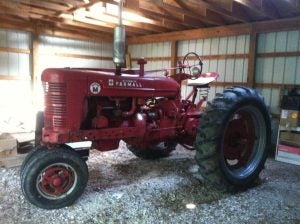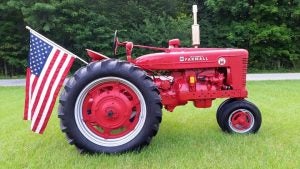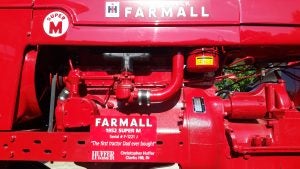“Doc, I don’t know if you know this, but I’ve got the first tractor your dad ever bought.”
I am a pulmonologist — a “lung doc,” if you’re from rural Indiana — and in 2011 I was starting practice in Lebanon, not far from my hometown of Delphi.
Rural farmers are notoriously hard on their lungs, and some of my first patients were old codgers who came to see the local boy made good. I had plenty of time back then, and we often talked of farming. My dad passed away in 2010, but he had farmed nearby since the late 1960s, and every patient I had from that area knew him.
“Will you sell that tractor to me?” I said.
He looked at me like it was the dumbest question he’d ever heard. “Of course I will,” he said.

It was a 1952 Farmall Super M, bright red, with a narrow front to fit between rows of corn. At the time it was made, it was the most powerful tractor that International Harvester made. I have only few memories of it as a boy. Dad and my uncle bought it used in the late 1960s when they first started farming. It originally had a mounted four-row cultivator, but by the time I was old enough to remember, it had been demoted to running small augers and mowing roadsides with a vicious-looking 7-foot sicklebar.
My uncle was the primary manager of the farm, which averaged about 5,000 acres year over year, and he sold the tractor around 2002 to my patient, who was a neighbor and occasionally drove a grain truck for him. The price was $2,000. It ran well, and had the typical wear for a tractor that age.
I bought the tractor from my patient a few months after I met him. We settled on the fair price of $2,800. He’d made some upgrades: it had a new starter, new plugs, a swinging drawbar, and new wiring. I knew he would have taken less for it. He knew I would have paid a lot more.
I had dreams of restoring the tractor to its original glory by myself. I bought books like “How to Restore Classic Farmall Tractors” by Therran Gaines. But I didn’t know anything about tractor restoration. I had spent half my life learning about medicine and nothing else. Classic tractor restoration is a lot like medicine — you can’t learn it all from books; you have to dive in and do it. But I wasn’t about to have Dad’s first tractor be my first “patient” to practice on.
I did some internet research and found Devon Wilkins of Devon’s Tractor Parts in Westfield, Indiana. We spoke on the phone and I hauled the tractor to him. “Make it like new,” I said.

About seven months later he had it done. It was expensive, but wow was it ever beautiful. Since then, I have taken the Super M to dozens of tractor shows and parades. It has won a couple of awards, including “Best Tractor” at the Delphi Independence Day parade.
Dad was never a classic tractor collector. To him, tractors were for work, not for parading around. I sometimes think he’d shake his head at the money and time I’ve spent. But for me, it’s a way to hang on to some small piece of him. I get up in the seat, fire it up, and take a drive out in the country. I look out over the cornfields and think about him riding this same tractor and it brings me joy. I don’t think he’d mind too much.



